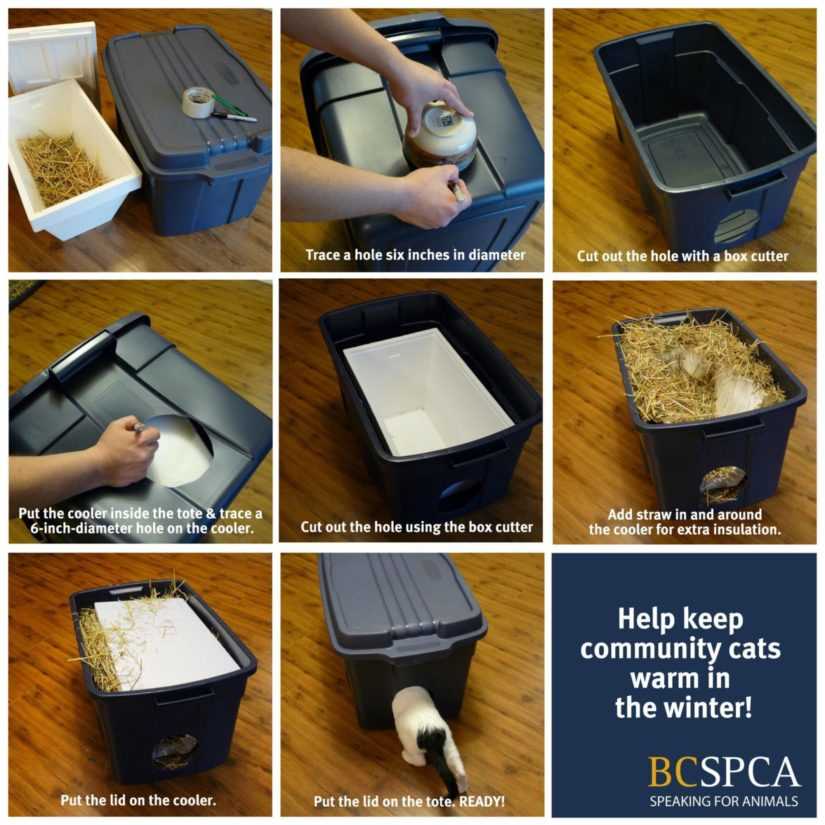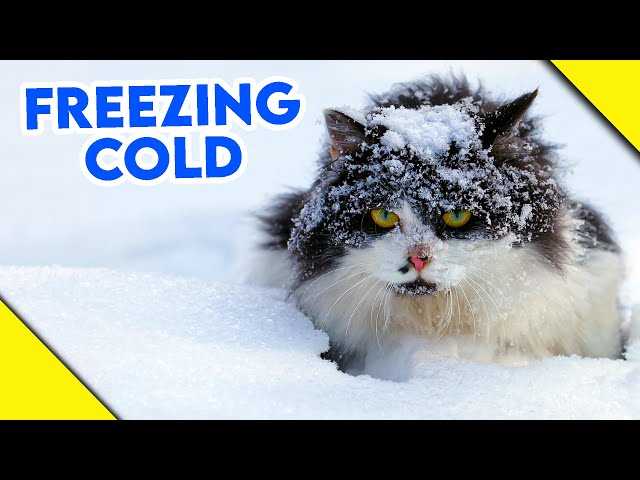



Providing a sheltered space is essential. A well-insulated house made from weather-resistant materials can offer the perfect retreat. Ensure it’s sturdy, elevated to avoid dampness, and has a flap or door to keep out drafts.
Using straw as bedding can significantly enhance comfort. Unlike blankets, straw doesn’t retain moisture, keeping the interior dry and snug. Regularly check and replace it as needed to maintain cleanliness.
Feeding plenty of nutritious food is crucial. Increased caloric intake helps maintain energy levels, which supports body heat. Consider adding a warm water source to keep hydration levels optimal, as this also assists with overall well-being.
Consider providing heat sources like warming pads or heated beds specifically designed for outdoor use. These can be battery-operated or solar-powered, offering additional comfort without the risk of overheating.
Finally, regular health check-ups are important. A healthy feline is better equipped to handle lower temperatures. Monitor for any signs of distress or illness, and consult a vet if any concerns arise.
How to Ensure Comfort for Felines in Cold Weather
Place insulated shelters in your yard. These can be made from sturdy materials like wood or plastic, with proper ventilation to avoid moisture buildup. Use straw as bedding; it insulates better than blankets and doesn’t retain moisture.
Consider using heating pads designed for outdoor use. These are safe and can be placed in the shelter to provide extra heat on particularly frigid nights. Ensure they are weatherproof and have a thermostat for safety.
Feeding Strategies

Increase food portions during colder months. More calories help generate body heat. Offer a high-quality diet with sufficient protein to maintain energy levels. Regular feeding times also help establish routines, which are comforting.
Water Management
Prevent water from freezing by using heated bowls. These will ensure hydration remains accessible even in low temperatures. Change the water regularly to keep it fresh and appealing.
Choosing the Right Shelter for Your Outdoor Cats

Opt for insulated structures that resist harsh conditions. Materials like wood or insulated plastic work best, as they provide excellent insulation against the chill. Avoid metal, as it can become too cold to touch.
Ensure the entrance is small enough to retain heat but large enough for easy access. A flap door or a tunnel design can shield from wind while allowing entry.
Elevating the shelter off the ground prevents moisture accumulation and cold seepage. Use wooden pallets or cinder blocks for stability and insulation from the ground.
Consider adding a removable, insulated lining made of fleece or straw for added comfort. Straw is preferable to blankets, as it doesn’t retain moisture and provides insulation.
Place the shelter in a sheltered area, away from direct wind and rain. Choose a location with some natural cover, like bushes or trees, to provide additional protection.
Regularly check the shelter to ensure it’s clean and dry. Replace bedding materials as needed to maintain a cozy environment.
Providing Adequate Bedding and Insulation for Warmth

Use straw or hay as bedding material. Unlike blankets, straw allows for insulation while keeping moisture away. It traps heat and provides a cozy spot for resting. Avoid using materials that can absorb water, as they become cold and uncomfortable.
Elevate the bedding off the ground to prevent heat loss. A wooden platform or pallets work well. This separation from the cold ground keeps the sleeping area warmer and dry.
Consider adding a layer of insulation inside the shelter. Foam boards can be cut to fit the interior walls, adding an extra buffer against the chill. Make sure they are secured safely to avoid any hazards.
Regularly check and replace bedding to maintain cleanliness. Wet or soiled materials can lead to discomfort and health issues. Fresh bedding not only feels better but also helps in retaining heat effectively.
If you’re curious about other food options for me, check out if can cats eat artichokes. Keeping me well-fed also helps with my warmth!
Providing a sheltered space is essential. A well-insulated house made from weather-resistant materials can offer the perfect retreat. Ensure it’s sturdy, elevated to avoid dampness, and has a flap or door to keep out drafts.
Using straw as bedding can significantly enhance comfort. Unlike blankets, straw doesn’t retain moisture, keeping the interior dry and snug. Regularly check and replace it as needed to maintain cleanliness.
Feeding plenty of nutritious food is crucial. Increased caloric intake helps maintain energy levels, which supports body heat. Consider adding a warm water source to keep hydration levels optimal, as this also assists with overall well-being.
Consider providing heat sources like warming pads or heated beds specifically designed for outdoor use. These can be battery-operated or solar-powered, offering additional comfort without the risk of overheating.
Finally, regular health check-ups are important. A healthy feline is better equipped to handle lower temperatures. Monitor for any signs of distress or illness, and consult a vet if any concerns arise.
How to Ensure Comfort for Felines in Cold Weather
Place insulated shelters in your yard. These can be made from sturdy materials like wood or plastic, with proper ventilation to avoid moisture buildup. Use straw as bedding; it insulates better than blankets and doesn’t retain moisture.
Consider using heating pads designed for outdoor use. These are safe and can be placed in the shelter to provide extra heat on particularly frigid nights. Ensure they are weatherproof and have a thermostat for safety.
Feeding Strategies

Increase food portions during colder months. More calories help generate body heat. Offer a high-quality diet with sufficient protein to maintain energy levels. Regular feeding times also help establish routines, which are comforting.
Water Management
Prevent water from freezing by using heated bowls. These will ensure hydration remains accessible even in low temperatures. Change the water regularly to keep it fresh and appealing.
Choosing the Right Shelter for Your Outdoor Cats

Opt for insulated structures that resist harsh conditions. Materials like wood or insulated plastic work best, as they provide excellent insulation against the chill. Avoid metal, as it can become too cold to touch.
Ensure the entrance is small enough to retain heat but large enough for easy access. A flap door or a tunnel design can shield from wind while allowing entry.
Elevating the shelter off the ground prevents moisture accumulation and cold seepage. Use wooden pallets or cinder blocks for stability and insulation from the ground.
Consider adding a removable, insulated lining made of fleece or straw for added comfort. Straw is preferable to blankets, as it doesn’t retain moisture and provides insulation.
Place the shelter in a sheltered area, away from direct wind and rain. Choose a location with some natural cover, like bushes or trees, to provide additional protection.
Regularly check the shelter to ensure it’s clean and dry. Replace bedding materials as needed to maintain a cozy environment.
Providing Adequate Bedding and Insulation for Warmth

Use straw or hay as bedding material. Unlike blankets, straw allows for insulation while keeping moisture away. It traps heat and provides a cozy spot for resting. Avoid using materials that can absorb water, as they become cold and uncomfortable.
Elevate the bedding off the ground to prevent heat loss. A wooden platform or pallets work well. This separation from the cold ground keeps the sleeping area warmer and dry.
Consider adding a layer of insulation inside the shelter. Foam boards can be cut to fit the interior walls, adding an extra buffer against the chill. Make sure they are secured safely to avoid any hazards.
Regularly check and replace bedding to maintain cleanliness. Wet or soiled materials can lead to discomfort and health issues. Fresh bedding not only feels better but also helps in retaining heat effectively.
If you’re curious about other food options for me, check out if can cats eat artichokes. Keeping me well-fed also helps with my warmth!
Providing a sheltered space is essential. A well-insulated house made from weather-resistant materials can offer the perfect retreat. Ensure it’s sturdy, elevated to avoid dampness, and has a flap or door to keep out drafts.
Using straw as bedding can significantly enhance comfort. Unlike blankets, straw doesn’t retain moisture, keeping the interior dry and snug. Regularly check and replace it as needed to maintain cleanliness.
Feeding plenty of nutritious food is crucial. Increased caloric intake helps maintain energy levels, which supports body heat. Consider adding a warm water source to keep hydration levels optimal, as this also assists with overall well-being.
Consider providing heat sources like warming pads or heated beds specifically designed for outdoor use. These can be battery-operated or solar-powered, offering additional comfort without the risk of overheating.
Finally, regular health check-ups are important. A healthy feline is better equipped to handle lower temperatures. Monitor for any signs of distress or illness, and consult a vet if any concerns arise.
How to Ensure Comfort for Felines in Cold Weather
Place insulated shelters in your yard. These can be made from sturdy materials like wood or plastic, with proper ventilation to avoid moisture buildup. Use straw as bedding; it insulates better than blankets and doesn’t retain moisture.
Consider using heating pads designed for outdoor use. These are safe and can be placed in the shelter to provide extra heat on particularly frigid nights. Ensure they are weatherproof and have a thermostat for safety.
Feeding Strategies

Increase food portions during colder months. More calories help generate body heat. Offer a high-quality diet with sufficient protein to maintain energy levels. Regular feeding times also help establish routines, which are comforting.
Water Management
Prevent water from freezing by using heated bowls. These will ensure hydration remains accessible even in low temperatures. Change the water regularly to keep it fresh and appealing.
Choosing the Right Shelter for Your Outdoor Cats

Opt for insulated structures that resist harsh conditions. Materials like wood or insulated plastic work best, as they provide excellent insulation against the chill. Avoid metal, as it can become too cold to touch.
Ensure the entrance is small enough to retain heat but large enough for easy access. A flap door or a tunnel design can shield from wind while allowing entry.
Elevating the shelter off the ground prevents moisture accumulation and cold seepage. Use wooden pallets or cinder blocks for stability and insulation from the ground.
Consider adding a removable, insulated lining made of fleece or straw for added comfort. Straw is preferable to blankets, as it doesn’t retain moisture and provides insulation.
Place the shelter in a sheltered area, away from direct wind and rain. Choose a location with some natural cover, like bushes or trees, to provide additional protection.
Regularly check the shelter to ensure it’s clean and dry. Replace bedding materials as needed to maintain a cozy environment.
Providing Adequate Bedding and Insulation for Warmth

Use straw or hay as bedding material. Unlike blankets, straw allows for insulation while keeping moisture away. It traps heat and provides a cozy spot for resting. Avoid using materials that can absorb water, as they become cold and uncomfortable.
Elevate the bedding off the ground to prevent heat loss. A wooden platform or pallets work well. This separation from the cold ground keeps the sleeping area warmer and dry.
Consider adding a layer of insulation inside the shelter. Foam boards can be cut to fit the interior walls, adding an extra buffer against the chill. Make sure they are secured safely to avoid any hazards.
Regularly check and replace bedding to maintain cleanliness. Wet or soiled materials can lead to discomfort and health issues. Fresh bedding not only feels better but also helps in retaining heat effectively.
If you’re curious about other food options for me, check out if can cats eat artichokes. Keeping me well-fed also helps with my warmth!












